
The suburbs and exurbs continue to dominate population growth in the nation’s 53 major metropolitan areas, according to a City Sector Model (Note 1 and Figure 9) analysis. We traced growth between the 2010 Census and the American Community Survey 5-year data, from samples taken over the period of 2014 to 2018. The middle-year was 2016 (Note 2).
Population Growth by City Sector
In the years since the 2010 Census, the ACS 2014/2018 estimates indicate that the suburbs and exurbs attracted 91.8% of major metropolitan area population growth, while 8.2% of the growth was in the urban core (Figure 1).
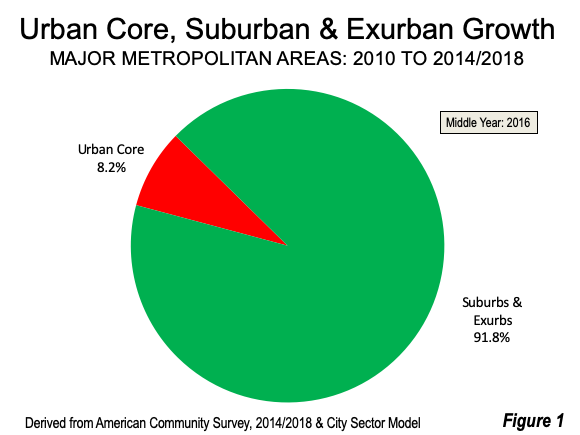
Among the five city sectors (defined in Figure 9), the three suburban and exurban sectors each had considerably more population growth than either of the two urban core sectors. Exurban areas, added more than twice the population as the two urban core sector combined (18.3% versus 8.2%). The Later Suburbs sector (generally outer suburbs) accounted for nearly one-half of the population growth (48.2%), while the Earlier Suburbs (generally inner suburbs) had 25.5% of the growth (Figure 2).
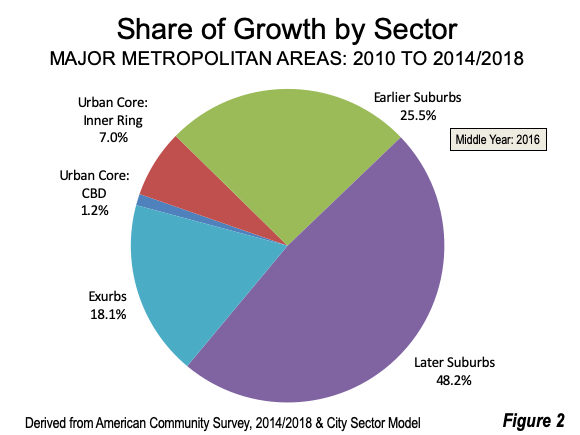
As a result, the share of the population living in suburban and exurban areas increased to 85.6% in 2014/2018, (Figure 2) up from the 85.3% in the 2010 Census (Figure 3).
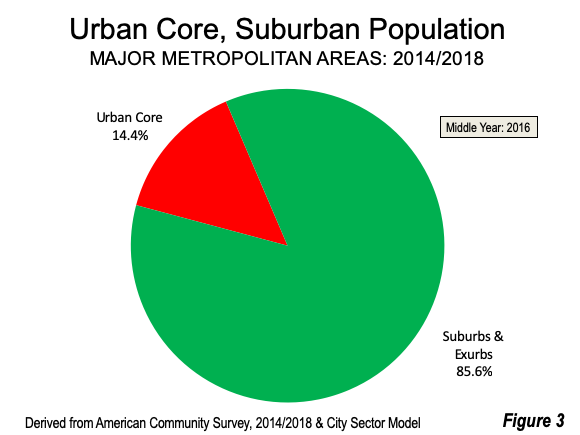
Comparing Growth Rates with 2010 Population Shares by Sector
The distribution of population growth over the period illustrates the continuing, if unheralded shift of population from the urban core to the suburbs and exurbs. Both urban core sectors enjoyed proportional growth less than their 2010 share of the population, while each of the suburban and exurban sectors gained at a rate more than their 2010 share.
The Urban Core: Central Business District, which garners much fawning media attention grew 1.2%, slightly slower than its 1.3% of the 2010 population. The Urban Core: Inner Ring accounted for 7.0% of the growth, little more than one-half of its 2010 population share. The Earlier Suburbs had 25.9% of the growth, about 40% less than its2010 population share of 41.9%. The Later Suburbs added 48.2% to their population, nearly 80% greater than their 2010 population share of 26.9%. The Exurbs added 18.1% in population, somewhat above their 16.4% 2010 population share (Figure 4).
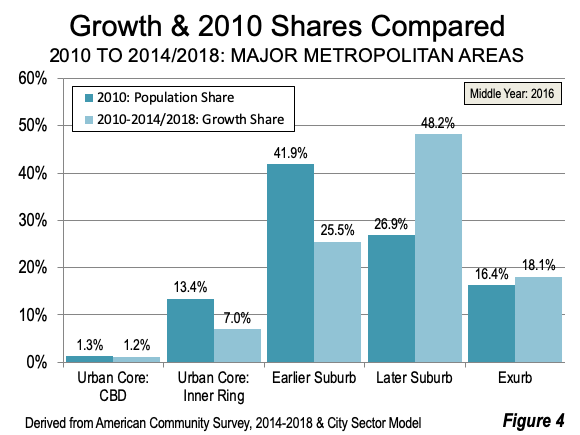
2010 Census and 2014/2018 Population
Despite their slower growth, the Inner Suburbs continued to have the largest share of the major metropolitan area population in 2014/2018, at 41.0%, followed by the Later Suburbs with 28.2% . The Exurbs had 16.5% of the population, up from 16.4%, the Urban Core: Inner Ring 13.1% and the Urban Core: Central Business District had the smallest share of the population, at 1.3% (Figure 5).
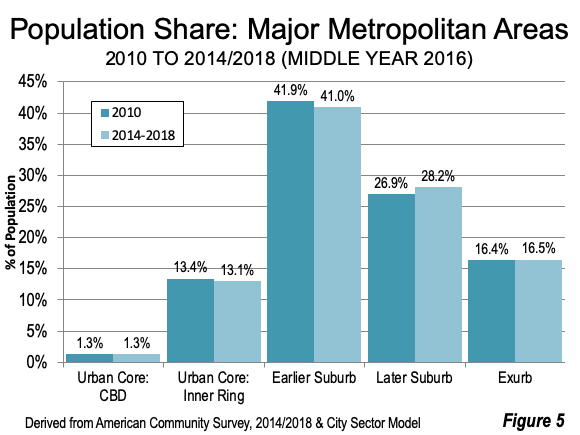
The numeric change in population is indicated in Figure 6. The greatest growth was in the Later Suburbs, at 4.2 million. The Earlier Suburbs grew by 2.5 million, while the Urban Core: Inner Ring added 0.8 million residents. The Urban Core: Central Business District sector gained 0.1 million.
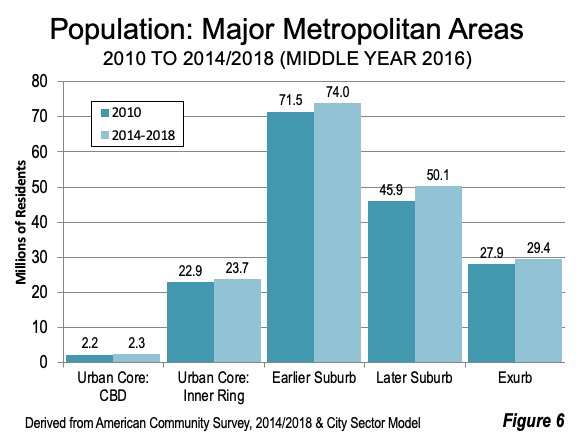
Growth by Type of Metropolitan Area
Among their many municipalities, six of the major metropolitan areas have “transit legacy cities” (the municipalities of New York, Chicago, Philadelphia, San Francisco, Boston and Washington), which combined account for nearly 60% of all transit work trip destinations in the United States. These six municipalities also are home to the largest historic central business districts (CBDs) and have high density urban cores that resemble their pre-World War II urban form.
The largest transit legacy city is New York, which by virtue of its large and particularly dense urban core is in a category by itself. Uniquely, New York’s population growth has been strongly concentrated in the urban core, with a 76.8%, share.During the decade, New York has been densifying, as population growth share exceeds the 2010 urban core population share of 52.8%. The suburbs and exurbs had only 23.2% of the population growth.
The other five metropolitan areas with transit legacy cities were far less dense in their development trajectory. They saw 24.2% of their growth in their urban cores, compared to their 24.0% urban core population shares in 2010. The suburbs and exurbs accounted for 76.0% of the growth.
In the 47 major metropolitan areas without transit legacy cities, 3.2% of the population growth was in the urban core, and 96.8% in the suburbs and exurbs (Figure 7).
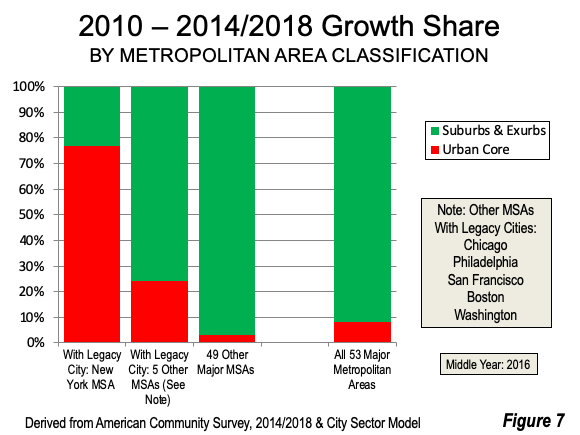
Clearly dynamic core urban growth in comparison with suburban areas is largely a New York phenomena, proportional in the other “legacy cities” and minuscule in the rest of urban America.
Greater Growth Outside the Metropolitan Areas without Legacy City Cores
Cities with stronger cores generally enjoyed slower growth.The six metropolitan areas with transit legacy cities are growing less quickly than the other 47. New York, which had 11.0% of the major metropolitan area population in 2010, grew by only 4.1% from 2010 to 2014/2018. The other five metropolitan areas with transit legacy cities had 15.2% of the population in 2010, and accounted for only 9.8% of the population growth. The 47 major metropolitan areas without transit legacy cities had 73.7% of the population in 2010 and had 86.1% of the population growth (Figure 8).None of the metropolitan areas with transit legacy cities stood among the fastest growing. Washington ranked 18th in percentage growth, San Francisco 18th, Boston 32nd, New York 40th, Philadelphia 42nd and Chicago 46th.
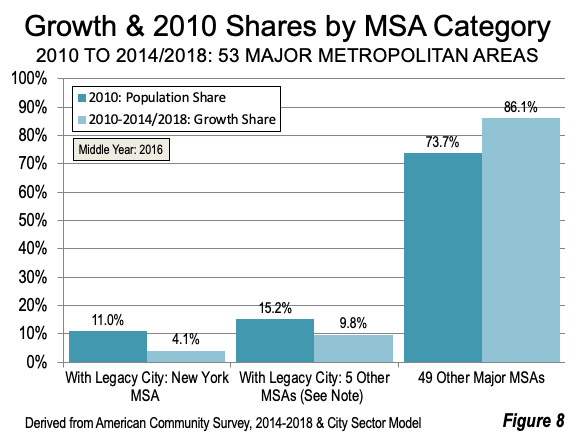
This trend could accelerate in future reports. On average, the metropolitan areas with transit legacy cities experienced a 70% decline in annual numeric growth from 2016 to 2018, compared to the average rate from 2010 to 2016. Among the other 47 major metropolitan areas, annual growth dropped as well, but only by 14%.
The Continuing Pattern: Suburbanization and Moving Away from Density
The latest ACS estimates indicate a continuing pattern of the greatest growth in suburbs and exurbs. At the same time, the metropolitan areas with the densest urban cores and largest central business districts are growing more slowly than the much maligned metropolitan areas with smaller urban cores.
Note 1: The City Sector Modelclassifies small areas (ZIP codes, more formally, ZIP Code Tabulation Areas, or ZCTAs) in metropolitan areas in the nation based upon their function as urban cores, suburbs, or exurbs. The criteria used are generally employment and population densities and the extent of transit use versus car use (Figure 9). The purpose of the urban core sectors is to replicate, to the best extent possible, the urban form as it existed before World War II, when urban densities were much higher and a far larger percentage of urban travel was on mass transit. The suburban sectors replicate the automobile-oriented suburbanization that began in the 1920s and escalated strongly following World War II. The suburban areas are largely within the continuous built-up urban areas, while the exurban areas are generally in the metropolitan areas, but outside the built-up urban areas.
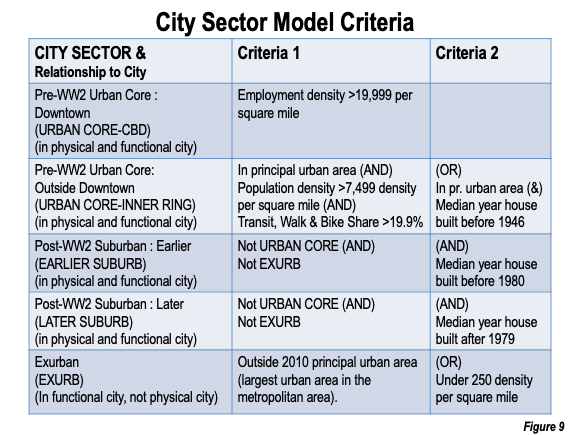
Note 2: The ACS 2014-2018 is the most current release of the ACS 5-year product, which is released annually. It is the result of equally weighted surveys taken in each year from 2014through 2018.Thus, characterizing results from the 2014-2018 ACS as 2017 data is inappropriate, since 80 percent of the data was collected in years before 2018. The middle year of the 2014-2018 release is 2016, making it the most representative year for the smaller geographies not reported in the annual sample, such as census tracts and zip codes (as used in the City Sector Model). This includes zip codes, which are used in the small area analysis produced by the City Sector Model (Note 2).
Photograph: Suburban Chicago, where 77% of the growth was in the suburbs and exurbs from 2010 to 2014/2018 (by author).
Wendell Cox is principal of Demographia, an international public policy and demographics firm. He is a Senior Fellow of the Center for Opportunity Urbanism (US), Senior Fellow for Housing Affordability and Municipal Policy for the Frontier Centre for Public Policy (Canada), and a member of the Board of Advisors of the Center for Demographics and Policy at Chapman University (California). He is co-author of the "Demographia International Housing Affordability Survey" and author of "Demographia World Urban Areas" and "War on the Dream: How Anti-Sprawl Policy Threatens the Quality of Life." He was appointed by Mayor Tom Bradley to three terms on the Los Angeles County Transportation Commission, where he served with the leading city and county leadership as the only non-elected member. Speaker of the House of Representatives appointed him to the Amtrak Reform Council. He served as a visiting professor at the Conservatoire National des Arts et Metiers, a national university in Paris.












